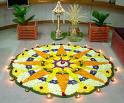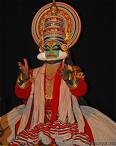Free, Online Resources to Learn Malayalam!
Onam Festival in Kerala
 Onam Festival falls in the month of Chingham (Aug-Sept). It is the harvest festival of Kerala. Legend states that Onam is celebrated as the home coming of Mahabali, the king who ruled over Kerala in the age of plenty and was pushed down to the infernal regions (Patala) by Lord Vishnu in the form of Vamana Onam Festival falls in the month of Chingham (Aug-Sept). It is the harvest festival of Kerala. Legend states that Onam is celebrated as the home coming of Mahabali, the king who ruled over Kerala in the age of plenty and was pushed down to the infernal regions (Patala) by Lord Vishnu in the form of Vamana
Onam is a time for sports, festivities and ritual celebrations in Kerala. The Keralites celebrate this festival in memory of the golden era of King Mahabali whose spirit is said to visit the state at the time of Onam Festival. Colorful aquatic festivals are organized along the sacred River Pampa as part of the celebrations.
After three months of heavy rains, the sky becomes a clear blue and the forests a deep green. The brooks and streams come alive, spouting a gentle white foam, the lakes and rivers overflow and lotuses and lilies are in full bloom as if to welcome the spirit of the King. It is time to reap the harvest, to celebrate and to rejoice.
Depending on the positioning of the stars and the moon, the festival is held at the end of August or beginning of September, less than a fortnight after the Malayalam New Year, Chingam begins. The biggest festival of Kerala, Onam is also the best time to plan one's travel and tour in Kerala. The color, enthusiasm and celebrations associated with Onam are enough to make you return again.
 The celebrations begin within a fortnight of the Malayalam New Year and go on for ten days. The last day called the Thiruonam is the most important. All over the state, rituals along with new clothes, traditional cuisine, dance and music mark this harvest festival. The celebrations begin within a fortnight of the Malayalam New Year and go on for ten days. The last day called the Thiruonam is the most important. All over the state, rituals along with new clothes, traditional cuisine, dance and music mark this harvest festival.
In Trichur, a vibrant procession with resplendently caparisoned elephants is taken out while at Cheruthuruthy, people gather to watch Kathakali performers enact scenes from epics and folk tales.
 |
Pulikali, also known as Kaduvakali is a common sight during Onam season. Performers painted like tigers in bright yellow, red and black, dance to the beats of instruments like udukku and thakil. |
Tourists on vacation in Kerala during Onam Festival can also witness the famous snake boat races of Kerala. At Aranmulla, where there is a temple dedicated to Lord Krishna and Arjuna, thousands of people gather on the banks of the River Pampa to witness the exciting snake boat races. Nearly 30 chundan vallams or snake boats participate in the festival.
Singing traditional boat songs, the oarsmen, in white dhotis and turbans, splash their oars into the water to guide their boats to cruise along like a fish on the move. The golden lace at the head of the boat, the flag and the ornamental umbrella at the center make it a spectacular show of pageantry too. |
 |
Each snake boat belongs to a village along the banks of the River Pampa and is worshipped like a deity. Every year the boat is oiled mainly with fish oil, coconut shell, and carbon, mixed with eggs to keep the wood strong and the boat slippery in the water. The village carpenter carries out annual repairs lovingly and people take pride in their boat, which represents their village and is named after it.
 |
The swing is another integral part of Onam, especially in the rural areas. Young men and women, decked in their best, sing Onappaattu, or Onam songs, and rock one another on swings slung from high branches. |
Like any other festival in Kerala, the festival completes with plenty of feasting with family and friends and exchange of gifts.
Onam Festival

|







 Onam Festival falls in the month of Chingham (Aug-Sept). It is the harvest festival of Kerala. Legend states that Onam is celebrated as the home coming of Mahabali, the king who ruled over Kerala in the age of plenty and was pushed down to the infernal regions (Patala) by Lord Vishnu in the form of Vamana
Onam Festival falls in the month of Chingham (Aug-Sept). It is the harvest festival of Kerala. Legend states that Onam is celebrated as the home coming of Mahabali, the king who ruled over Kerala in the age of plenty and was pushed down to the infernal regions (Patala) by Lord Vishnu in the form of Vamana The celebrations begin within a fortnight of the Malayalam New Year and go on for ten days. The last day called the Thiruonam is the most important. All over the state, rituals along with new clothes, traditional cuisine, dance and music mark this harvest festival.
The celebrations begin within a fortnight of the Malayalam New Year and go on for ten days. The last day called the Thiruonam is the most important. All over the state, rituals along with new clothes, traditional cuisine, dance and music mark this harvest festival. 


